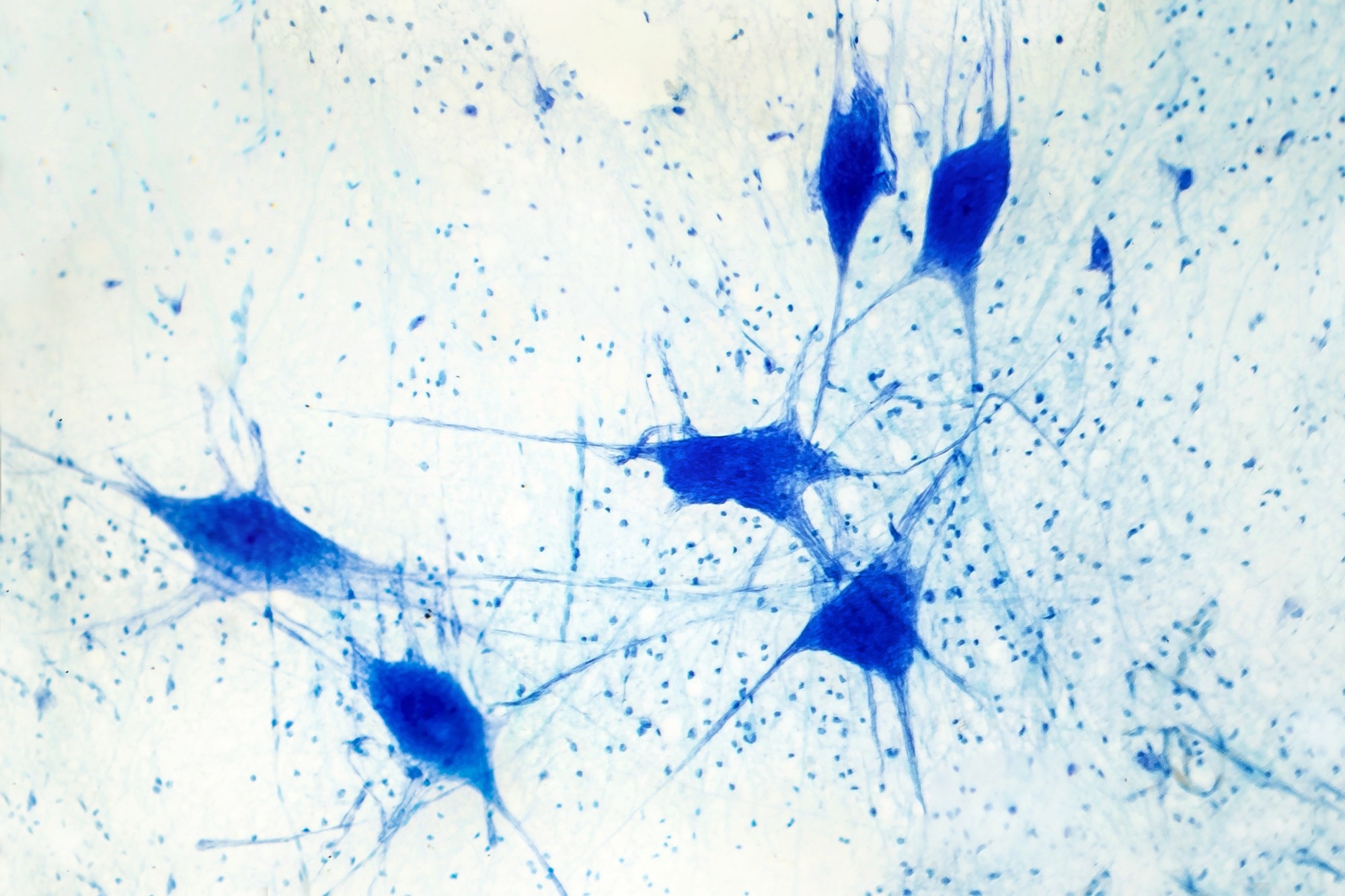 By Pooja Toshniwal PahariaReviewed by Lauren HardakerAug 7 2025
By Pooja Toshniwal PahariaReviewed by Lauren HardakerAug 7 2025In a recent study published in Proceedings of the National Academy of Sciences, researchers investigated the impact of β-glucocerebrosidase (GBA1) mutations in Parkinson’s disease (PD). They found that mutated GBA1 reduces the accessible cholesterol in primary cilia, impairing Sonic Hedgehog (Shh) signaling, essential for producing neuroprotective factors. Although distinct from LRRK2 mutations, which prevent cilia formation, both mutations reduce ciliary signaling and neuroprotection, suggesting a shared pathogenic pathway in PD.
 Image credit: Kateryna Kon/Shutterstock.com
Image credit: Kateryna Kon/Shutterstock.com
The study suggests that impaired Hedgehog signaling due to different upstream mechanisms may underlie dopaminergic neuron vulnerability in PD. Targeting ciliary Shh signaling or the underlying lipid imbalances that impair it could offer a novel therapeutic strategy for PD, particularly in individuals with GBA1 or LRRK2 mutations.
PD is a neurodegenerative disorder with sporadic and genetic forms characterized by dopamine-producing neuronal loss within the striatum. Mutations in the GBA1 and LRRK2 genes cause familial PD. LRRK2 mutations impair primary cilia development, thereby interfering with Sonic Hedgehog signaling and reducing the generation of neuroprotective factors, including glial cell line-derived neurotrophic factor (GDNF) and neurturin (NRTN). GBA1 mutations result in Gaucher disease, a genetic disorder of lysosomal storage, leading to the accumulation of glucosylsphingosine and glucocerebroside in lysosomes.
GBA1-associated PD often presents earlier and with more severe cognitive symptoms compared to idiopathic PD; however, the mechanisms linking GBA1 mutations to dopamine loss from neurons remain unclear. Individuals with PD and mutated GBA1 and LRRK2 genes often experience milder disease. This suggests the possibility of functional compensation in surviving cilia or signaling components. However, the underlying reasons remain unclear and may involve compensatory upregulation of Hedgehog pathway components in cells that retain cilia.
About the Study
In the present study, researchers explored the influence of lysosomal GBA1 in ciliary Shh signaling and its implications for PD pathogenesis through a distinct mechanism compared to LRRK2.
The team cultured NIH-3T3, mouse embryonic fibroblast (MEF), and human embryonic kidney 293T (HEK293T) cells. They generated Somatostatin Receptor 3 (SSTR3)-mApple-expressing NIH-3T3 cells through plasmid transfection and viral transduction, followed by flow cytometry selection. They then created GBA1 knockout NIH-3T3 cells using CRISPR-associated protein 9 (Cas9) and guide ribonucleic acids (guide RNA) via electroporation, followed by genotyping.
The researchers subjected the cells to multiple treatments to examine the effects of GBA1 dysfunction on cholesterol trafficking and Hedgehog signaling. U18666A blocked lysosomal cholesterol export via Niemann-Pick C1 protein (NPC1) inhibition, while conduritol beta epoxide (CBE) inhibited GBA1 to model lysosomal storage dysfunction. Cholesterol:methyl-beta-cyclodextrin (Chol:MβCD) delivered exogenous cholesterol, myriocin inhibited sphingomyelin synthesis, and recombinant Shh activated the Hedgehog pathway.
The team compared lysosome-localized accessible cholesterol in control fibroblasts and GBA1-mutant patient-derived fibroblasts (N370S, L444P) using mNeon-ALOD4 staining. They immunostained NIH-3T3 cells with antibodies against ADP-ribosylation factor-like 13B (Arl13b) to visualize cilia. Quantitative polymerase chain reaction (qPCR) revealed changes in cholesterol synthesis.
The researchers used GBA1 D409V mice, LRRK2 mutant mice, and wild-type controls to evaluate Hedgehog pathway signaling and neurotrophicity dysfunction in vivo. They stained murine brain tissues with antibodies for choline acetyltransferase (ChAT), aldehyde dehydrogenase-1 family member L (ALDH1L1), and adenylate cyclase type 3 (AC3) or Arl13b to assess changes in cholinergic neurons, astrocytes, and primary cilia, respectively. Fluorescence in situ hybridization (FISH) quantified gene expression changes, and confocal microscopy enabled detailed imaging and analysis.
Results
Inhibition of NPC1-mediated lysosomal cholesterol export using U18666A significantly reduced accessible cholesterol at the primary cilium of NIH-3T3 cells within 72 hours, accompanied by decreased expression of Hedgehog (Shh)-responsive genes, GLI family zinc finger 1 (GLI1), and Patched Homolog 1 (PTCH1). The findings indicate that lysosomal cholesterol accumulation impairs Shh signaling.
Consistent with this, GBA1-mutant human fibroblasts and CBE-treated cells showed significant accumulation of accessible cholesterol in lysosomes. GBA1 knockout NIH-3T3 cells and GBA1 D409V mutant MEFs displayed markedly reduced ciliary accessible cholesterol. Furthermore, GBA1 inhibition upregulated cholesterol biosynthesis genes, indicating cellular compensation for microlocalized cholesterol.
The genes included 3-hydroxy-3-methylglutaryl-CoA synthase 1 (HMGCS1), 3-hydroxy-3-methylglutaryl-CoA reductase (HMGCR), low-density lipoprotein receptor (LDLR), ATP citrate lyase (ACLY), and Sterol Regulatory Element Binding Protein 2 (SREBP2). Restoring plasma membrane cholesterol via exogenous cholesterol or inhibiting sphingomyelin synthesis rescued Shh signaling in GBA1-inhibited cells, supporting the role of cholesterol depletion at the cilium in pathway dysfunction.
Functionally, both CBE-treated NIH-3T3 cells and GBA1 D409V MEFs exhibited reduced expression of Shh target genes GLI1 and PTCH1, despite normal cilia formation, indicating impaired Shh signal transduction rather than ciliogenesis. In contrast, LRRK2 mutations block Shh signaling by disrupting cilia formation.
In GBA1 D409V mice, striatal cholinergic neurons and astrocytes formed normal primary cilia. However, astrocytes showed reduced brain-derived neurotrophic factor (BDNF) and PTCH1 expression, and cholinergic neurons displayed decreased PTCH1 and approximately 50% lower GDNF RNA levels, indicating impaired Shh pathway. Notably, while these neurons retain cilia, the lipid composition of the ciliary membrane is altered, rendering them unable to transduce the Shh signal. GBA1 and LRRK2 mutations suppressed Hedgehog-induced BDNF expression in striatal astrocytes, highlighting a shared disruption of neurotrophic signaling via distinct upstream mechanisms.
Conclusions
The study findings demonstrate that GBA1 mutations impair ciliary Hedgehog signaling by disrupting lipid composition and depleting accessible cholesterol, reducing neuroprotective factors. Although LRRK2 mutations block the same pathway through impaired cilia formation, both converge on a shared mechanism of reduced ciliary signaling and neurotrophic support. This convergence may help explain the selective vulnerability of dopaminergic neurons despite widespread expression of these genes.
The common downstream effect may underlie dopaminergic neuron vulnerability and Parkinson’s disease progression, resembling neurodegenerative mechanisms seen in aging. Furthermore, the authors note that chronic GBA1 deficiency may trigger adaptive changes that differ from acute inhibition, highlighting the importance of temporal context in disease modelling.
The study also points to the broader relevance of primary cilia in neural circuit regulation. These subtle ciliary signaling defects may have wide-reaching effects on neural circuitry, particularly in brain regions reliant on Shh-mediated neurotrophic support.
Download your PDF copy now!
Journal Reference
Sreeja V. Naira, Ebsy Jaimon, Ayan Adhikari, Jonas Nikoloff, and Suzanne R. Pfeffer. (2025). Lysosomal glucocerebrosidase is needed for ciliary Hedgehog signaling: A convergent pathway contributing to Parkinson’s disease. Proceedings of the National Academy of Sciences, 122(31):e2504774122. DOI:10.1073/pnas.2504774122. https://www.pnas.org/doi/10.1073/pnas.2504774122